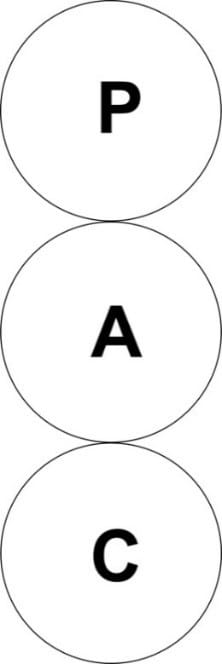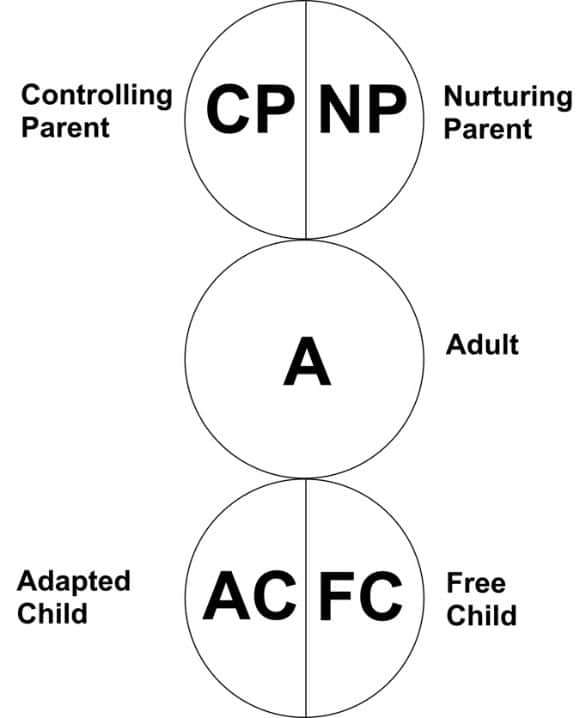What are Ego States?
by Steve Rigler
An ego state is a way in which we think, feel and behave, making up our personality at a given time.
These states are thinking and feeling as a:
- Parent
- Adult
- Child
One of the most prominent aspects of the personality theory of Transactional Analysis (Berne, 1961) is the ego state concept.
Eric Berne suggested that an ‘ego state’ (1961, p.17):
“May be described phenomenologically as a coherent system of feelings related to a given subject, and operationally as a set of coherent behavior patterns; or pragmatically, as a system of feelings which motivates a related set of behavior patterns.”

Berne developed Transactional Analysis after his training in psychoanalysis.
Although Berne made major contributions to the ego state theory, he did not coin the term ‘ego’ or ‘ego state’ as the word ‘ego’ is Latin meaning ‘I’ or 'self'.
Berne built upon Sigmund Freud’s model of the id, ego and super-ego (Freud, 1989) and adapted post-Freudian Paul Federn’s concepts of ego states, which supplemented Freud’s ideas with observable behaviour.
The Basics of the Ego State Models
There are two basic models of ego states:
- the structural model
- the functional model (referred to as the behavioural model in the latest version of the ‘TA 101’ syllabus)
To understand what an ego state is, referring to the two basic models helps explain and get to grips with the theory.
Starting with the structural model, it uses three stacked circles and is one of the elementary units of Transactional Analysis.
Each ego state starts with a capital letter to denote the difference between actual parents, adults and children as shown below.
The Structural Model of Ego States
The theory suggests that our personality is divided, but not necessarily in equal proportions, into the Parent, the Adult and the Child ego states.
The Parent Ego
The Parent ego state refers to the behaviours, thoughts and feelings that are copied, learned or even borrowed from our parents, parental figures, or significant others.
Parental figures/significant others are not necessarily biological, but maybe someone with power, authority or influence that have had an impact on us during our childhood. These may be teachers, priests, or even movie heroes.
The Adult Ego
The Adult ego state operates in the here and now and rationally processes what we are thinking and feeling, which is based on facts without interference of unconscious contamination.
We are thinking and responding appropriately, displaying logical and consistent behaviour. Put simply, this is us being us, without those external influences of our Parent and Child ego states.

The Child Ego
The Child ego state is not when we are acting childish, or what others perceive as childish behaviour. It is how we behaved, thought and felt, replayed out as we did as a child.
These adaptive behaviours can be immediate and act as a survival instinct within us, putting obstacles in the way of our own growth.
These are archaic memories that we are unable to remember on a conscious level, but lie within our unconscious.
The Functional Model of Ego States
The functional model diagrams how we use what is in the structural model, and reflects the descriptions of the component parts of the ego states.
Subdividing the states and giving them behavioural descriptions enables a more explicit way of observing behaviour.
The Parent is divided into Controlling Parent (sometimes still described as Critical Parent) and Nurturing Parent.
The Child is divided into Adapted Child and Free Child.
Controlling and Adapted are on the left of the diagram, with Nurturing and Free on the right, although not for any reason that I have been able to establish apart from it needs to go somewhere in order to diagram.

Behaving, thinking and feeling in ways we have copied from our parents, like criticizing someone, I am said to be in Controlling Parent.
For example, I may say something like “Don’t run out in the road” to a child. Alternatively, when I replay the behaviours my parents showed me when they tucked me into bed when I am ill, looking after and caring for me, I am said to be in Nurturing Parent.
Adapting to the demands of my parents or parental figures, behaving, thinking and feeling in ways that were imprinted on us as a child, I am said to be in Adapted Child.
Without parental pressures or demands, and acting as we wanted to without influence, like simply playing or making a sand castle and losing ourselves in our own world, we are said to be in Free Child.
With this theory, it now starts to become clear that the theory is observable, and expands on the basic structural model.
Free Handout Download
Structural and Functional Models of Ego States
Recognising Ego States and Observable Behaviours
Berne (1961, p. 76) listed four ways of recognising ego states and how they manifest into observable behaviours. He called them behavioural, social, historical and phenomenological diagnosis.
He suggests you could achieve a more exact diagnosis using more than one therapeutic analysis at a time, with behavioural diagnosis being the most important with the other three assisting.
Observing behaviour is a way to find what ego state a person is in by listening to their words, the tone in which they are used, body language, skin tone, hand gestures, facial expressions, body posture, eye movements and so on.
Observing the clues of the here and now within the counselling environment is referred to as ‘Immediacy’.
Observing behaviour is a way to find what ego state a person is in by listening to their words, the tone in which they are used, body language, skin tone, hand gestures, facial expressions, body posture, eye movements and so on.
A historical diagnosis relates to interactions and experiences as a child with parents and parental figures.
If decorating at my home is discussed, this can place us in our Negative Adapted Child, as I would make a groaning noise and say something like, “Oh I hate decorating, it’s boring and I can’t be bothered”.
A good question for this may be “How did your parents act when they were decorating your home as a child?”
A phenomenological diagnosis may be described as re-experiencing the past, rather just remembering it.
Berne (1961) states that “a phenomenological diagnosis is validated if the individual can fully re-experience in full intensity, with little weathering”.
One way in which this theory could be used is by sitting in a chair, asking a parent (virtually in front of you) why he reacted the way he did with a particular experience you recall., and to see how that plays out.
References
Berne, E. (1961) Transactional Analysis in Psychotherapy. New York, Grove Press.
Freud, S. (1989 [1940]) An Outline of Psycho-Analysis (trans. J. Strachey), London, W. W. Norton & Company.
Stewart, I. and Joines, V. (2012) TA Today: A New Introduction to Transactional Analysis. 2nd edn. Melton Mowbray, Lifespace Publishing.